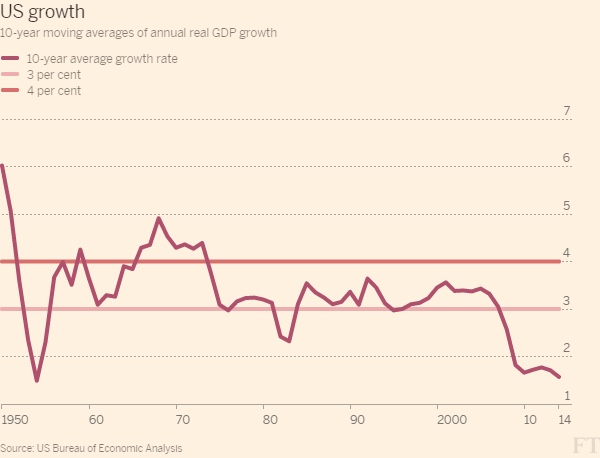“Could Trumponomics work?”
Kann das Programm von Trump funktionieren? Ich hatte hier schon mehrere Stimmen dazu. Ich selbst war ja anfangs optimistisch, sehe nun jedoch das Risiko der steigenden Zinsen. Dennoch ist das hier nicht so falsch:
→ „Mit Trump kommt die Reflation“
Nun die FT zu dem Thema:
- “The nominee for Treasury secretary, Steven Mnuchin, vowed in a recent interview to achieve sustained 3-4 per cent annual GDP growth. Critics have been scathing.” – bto: Es wäre in der Tat ein Ausbruch aus der Eiszeit.
- “Lawrence Summers wrote in the FT that ‚I can find no basis in either economic history or logic for Mr Mnuchin’s claim that the proposed reforms would increase the economy’s growth rate from its current 2 per cent rate to the historical 3 to 4 per cent norm. Adult population growth has slowed by nearly a percentage point, the gains generated by more women entering the workforce have been exhausted, and it is far from clear why tax reform will hugely spur productivity growth.‘” – bto: So argumentiere ich bekanntlich auch mit Blick auf Deutschland und Europa. Zu unrecht?
Quelle: Financial Times
- “Some serious people think Trumponomics might, just might, work. One is Kenneth Rogoff, who makes two simple but powerful points. The first is that “the biggest missing piece of the global recovery is business investment, and if it starts kicking in finally, both output and productivity could begin to rise very sharply”. That is as true in the US as elsewhere.” – bto: Das stimmt. Käme es wirklich zu einem Investitionsboom, könnte das helfen. Allerdings dürfte es da vor allem um Automatisierung und Effizienz gehen.
- “What matters, of course, is whether business investment will increase under a Trump economic policy. If it does, it could be because regulations are made business-friendly, because fiscal stimulus boosts aggregate demand and expectations of future demand growth, simply because there is something about Trump that changes the ‚animal spirits‘ of investors and business decision makers.” – bto: Bisher haben die Unternehmen nämlich das Geld lieber für Aktienrückkäufe ausgegeben. Insofern braucht es vor allem andere Zukunftserwartungen.
- “Whether greater spending leads to greater (sustained) growth depends on (…) whether there is much spare capacity in the economy today, or more intriguingly, whether supply capacity itself responds with faster productivity increases in a ‚high-pressure economy‘ of strong demand.” – bto: Das ist sicherlich richtig. Es könnte dazu führen.
- “Unemployment is now very low, so Summers is right that high job growth must rely on either an expanding population or increasing the share of the population that participates in the labour force. (…) The US is seriously underperforming relative to its own record on employment. The employment-to-population ratio for 25 to 54-year-olds (which should not be affected by ageing or college attendance) is 78.1 per cent, almost four points below the record set in the last year of the Bill Clinton presidency. The ratio for 16 to 24-year-olds is 10 points down. Restoring those ratios should add about 8m-9m jobs or 6 per cent of the current total.” – bto: ein Hebel, den wir in Deutschland übrigens auch haben, allerdings nicht in dem Umfang. Wir könnten weniger Urlaub machen, mehr Stunden pro Woche arbeiten und hätten insgesamt mehr Lebensarbeitszeit.
- “If the underlying labour force in addition expands as fast as the adult population growth rate — currently just over 1 per cent per year — that amounts to the labour supply growing at perhaps 1.6 per cent a year, which adds up to Trump’s 25m jobs over a decade. Surely this is not unrealistic. Japan shows that the labour force can grow faster than the working-age population as more people work later in life.” – bto: eine ohnehin erforderliche Maßnahme, um mit der Alterung finanziell umzugehen.
Quelle: Financial Times
- “(…) unless the rate of productivity growth ultimately recovers, even this is not enough to restore historical economic growth rates on a sustained basis. But it could be enough to restore them temporarily. And that, as Narayana Kocherlakota has suggested, could lead to investment and innovation that would spur productivity, which he argues happened after the Great Depression.” – bto: wobei es damals auch mit dem Zweiten Weltkrieg zusammenhing.
Fazit FT: “(…) it does show that it is foolish to think it is impossible for the US economy to achieve a permanently higher rate of growth with the right policies. One must hope that the new administration at least approximates some of those.”
– bto: eine Möglichkeit, die wir nicht von der Hand weisen können. Das Risiko bleiben die ansteigenden Zinsen. Diese könnten den Aufschwung ersticken, bevor er kommt.
→ FT (Anmeldung erforderlich): “Could Trumponomics work?”, 8. Dezember 2016









